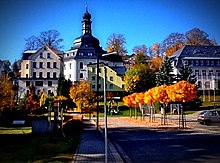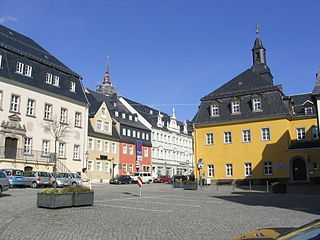
Zschopau, is a town in the Erzgebirgskreis district of Saxony, Germany.

Mittweida is a town in Saxony, Germany, in the Mittelsachsen district.

Adorf is a small town and municipality in the Vogtlandkreis to the south-west of the Free State of Saxony, Germany. Gettengrün, a village within the municipality, borders on the Czech Republic.

Königstein is a town on the river Elbe in Saxony in Germany. Königstein lies in the Sächsische Schweiz-Osterzgebirge District and had a population of 2,089 in 2018. It includes land on both banks of the Elbe, but the centre and most of the town lies to the south of the river. The Königstein Fortress is situated above and to the south-west of the town.

Frankenberg is a town in the district of Mittelsachsen, in Saxony, Germany. It is situated on the river Zschopau, 12 km (7.46 mi) northeast of Chemnitz, and some 40 km (24.85 mi) north of the border to the Czech Republic.

Oelsnitz is a town in the district Erzgebirgskreis, in Saxony, Germany. It is situated 14 km east of Zwickau, and 20 km southwest of Chemnitz. Between 1844 and 1971 hardcoal was mined in Oelsnitz and the surrounding towns. The major mine "Karl-Liebknecht" became a mining museum in 1986.
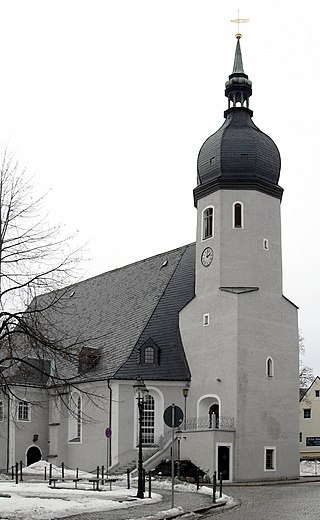
Olbernhau is a town in the district Erzgebirgskreis, in Saxony, Germany. It is situated in the Ore Mountains, 35 km southeast of Chemnitz, and 23 km north of Chomutov, Czech Republic.

Neustadt in Sachsen is a town in the Sächsische Schweiz-Osterzgebirge district, in Saxony, Germany. It is situated near the border with the Czech Republic, 35 km east of Dresden (centre), and 23 km southwest of Bautzen. At Neustadt, there is an Observation Tower at Goetzinger's Height, one of the oldest lattice towers in the world.
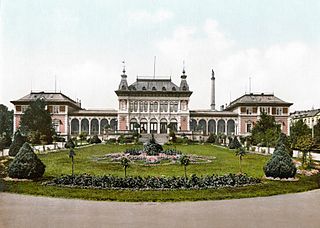
Bad Elster is a spa town in the Vogtlandkreis district, in Saxony, Germany. It lies on the border of Bavaria and the Czech Republic in the Elster gebirge hills. It is situated on the river White Elster, and is protected from extremes of temperature by the surrounding wooded hills. It is 25 kilometres (16 mi) southeast of Plauen, and 25 kilometres (16 mi) northwest of Cheb. It is part of the Freunde im Herzen Europas microregion.

Jöhstadt is a town in the district of Erzgebirgskreis, in Saxony, Germany. It is situated in the Ore Mountains, on the border with the Czech Republic, 10 km southeast of Annaberg-Buchholz, and 35 km northeast of Karlovy Vary.

Markneukirchen is a town in the Vogtlandkreis district, in Saxony, Germany, close to the Czech border. It lies in the Elster Mountains, 24 km (14.9 mi) southeast of Plauen, and 14 km (8.7 mi) northeast of Aš.

Neusalza-Spremberg is a town in the district Görlitz, in Saxony, Germany. It is situated on the border with the Czech Republic, on the river Spree, 6 km northwest of Ebersbach, and 17 km southeast of Bautzen.
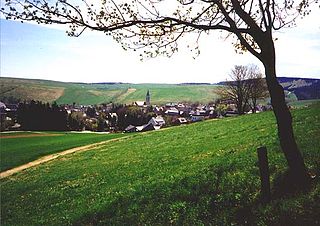
Oberwiesenthal is a town and a ski resort in the district of Erzgebirgskreis in Saxony in Germany. It is situated in the Ore Mountains, on the border with the Czech Republic, 19 km south of Annaberg-Buchholz, and 23 km northeast of Karlovy Vary. At 914 metres (2,999 ft), it is the highest town in Germany. The Olympic and World Championships goldmedalist in ski jumping Jens Weißflog competed for SC Tractor Oberwiesenthal and Oberwiesenthaler SV.

Sayda is a town in the district of Mittelsachsen, in Saxony, Germany. It is situated 24 km south of Freiberg, and 28 km north of Chomutov.

Schöneck is a town in the Vogtlandkreis district, in the Free State of Saxony, Germany. It is situated 18 km (11 mi) southeast of Plauen, and 35 km (22 mi) north of Cheb. Schöneck is known as the biggest ski resort in the eastern part of Germany. With more than 700 m (church) it is the highest-located town in the Vogtland district. It is in the 'music corner', a region so-called because of its history of production of musical instruments.
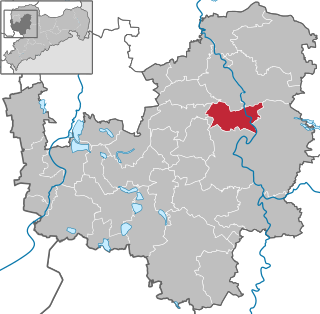
Trebsen is a town in the Leipzig district, in Saxony, Germany. It is situated on the river Mulde, 6 km northeast of Grimma, and 27 km east of Leipzig (centre).

Lichtenstein is a town in the Zwickau district, in Saxony, Germany. It is situated 11 km northeast of Zwickau, and 22 km southwest of Chemnitz. It was owned by the House of Schönburg from 1286 until 1945.

Elstertrebnitz is a municipality in Saxony, lying southwest of Leipzig and northeast of Zeitz.

Großschönau is a municipality in the district Görlitz, in Saxony, Germany located in the cross-border region with the Czech Republic. It used to be a famous Upper Lusatian center of Damask fabric production until the end of the 1980s. Since then it has turned into an area of tourism.

The Aschberg is a mountain on the border of Germany (Saxony) and the Czech Republic. It is part of the Ore Mountains. The summit lies on the Czech side, in the municipality of Bublava.








